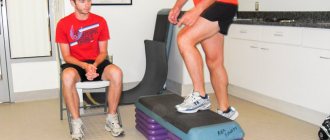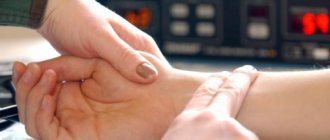An important skill for a nurse is the correct technique for taking an ECG (electrocardiogram). Let us recall that electrocardiography is a technique for recording the electrical fields of the heart that arise during its activity. as well as obtaining their graphic representation on paper or display. Electrocardiography is an informative and non-invasive method for studying the functioning of the heart - convenient and valuable for the patient and the attending physician.
An electrocardiogram is a graphic image in the form of a curve obtained during electrocardiography on paper or a display. ECG recording is carried out using devices called electrocardiographs. Any electrocardiograph has:
- input device;
- heart biopotential enhancer;
- recording device.
A nurse is allowed to work with an electrocardiograph only after training, preferably in the “Functional Diagnostics” specialization. ECG registration is carried out in a specially adapted and equipped room, as well as in the ward at the patient’s bedside, at home, at the point of medical care, or in an ambulance.
The ECG room should be located away from any suspected sources of electrical noise. It is advisable to shield the couch: it is covered with a special blanket with a sewn-in grounded (!) metal mesh.
What is an ECG?
Electrocardiography is a non-invasive technology for graphically recording the potential difference in the electric field generated during the work of the heart. It is carried out using an electrocardiograph.
Electrocardiograph
The device has electrodes that are attached to certain points on the patient's body. They capture the electrical impulses of the heart, which, after amplification, are recorded by a galvanometer and recorded on paper using curved lines. The result is a cardiogram, which is subject to further interpretation by a cardiologist or therapist.
Goal and tasks
Taking an electrocardiogram is necessary for diagnosing disorders of the heart, and is also a mandatory element of the annual medical examination of the population. Cardiologists recommend an ECG every year for all people over 40 years of age.
Looking at the cardiogram, the doctor will evaluate:
- Frequency (pulse), rhythm and regularity of heart contractions.
- Physical condition of the heart.
- The presence of disturbances in electrolyte metabolism (potassium, calcium, magnesium and others).
- Conducting system of the heart (various blockades and arrhythmias).
- The effectiveness of treatment in acute and chronic diseases.
- Localization, size and degree of damage during ischemia and myocardial infarction.
- The presence of cardiac complications in diseases of other organs and systems (pulmonary embolism).
Reasons to get tested
A cardiogram is done at the slightest complaint:
- for interruptions in heart function;
- shortness of breath;
- heaviness and pain in the chest;
- weakness, dizziness;
- high blood pressure;
- pain in the back, chest and neck.
And:
- before operations;
- at medical examinations;
- during pregnancy;
- if there is a risk of developing heart disease;
- to obtain a medical record when applying for a job.
For a complete diagnosis, one cardiogram is not enough. The doctor will be able to draw conclusions about your health based on a comprehensive examination, taking into account the results of other examinations, tests, your complaints and medical history.
What kind of doctor does it?
At the clinic, a referral for cardiography is given by a therapist. And the doctor who deciphers it is called a cardiologist.
The following can also be concluded:
- functional diagnostics doctor;
- emergency doctor;
- Family doctor;
- pediatrician.
The procedure itself is carried out by nurses in a specially equipped room.
After receiving the test results, you must make an appointment with the doctor who prescribed the ECG to receive recommendations or treatment prescriptions.
Duration of the procedure
How long the study will last depends on the type of ECG.
| Type of study | Time |
| Standard ECG | 5–10 minutes |
| ECG with stress | 10–15 minutes |
Preparing the patient for an ECG
Electrocardiography is a technique for recording and studying the electric fields generated during the work of the heart. The direct result of electrocardiography is an electrocardiogram (ECG). [1]
12-vector ECG is the standard option for electrocardiography. It is performed in various situations, places and time periods, while attempts to achieve the best results are associated with following the rules for applying electrodes. In particular, the position of the person undergoing an ECG, the quality of skin preparation, and the location of the electrodes are important.
- Patient position
Many patients feel uncomfortable on a strictly horizontal surface, so to ensure proper results, a semi-recumbent position of approximately 45 degrees is recommended. Any significant deviations from this indicator should be noted in the description of the ECG.
Various studies have shown that an ECG recorded from a patient in a supine position can differ significantly from the results of a study of the same person only standing upright or tilted at an angle of 60 degrees or more. However, there is no evidence that changing the patient's inclination between horizontal and 45 degrees relative to the horizontal plane has a significant effect on ECG recording.
Limbs should be positioned on a bed or sofa to minimize artifacts due to muscle tension.
It is necessary that the patient is in a relaxed and comfortable state. If these conditions are not met, the ECG may record somatic muscle potentials as well as difficult cardiac activity.
Some patients are unable to fully relax due to painful conditions such as arthritis, or they have Parkinson's disease, which causes tremors. These patients should be positioned as comfortably as possible, and the resulting ECG should be accompanied by an appropriate explanation, especially if it is not very high quality.
Before recording an ECG, the patient's limbs are checked and must remain relaxed. If the patient clenches his fists, tenses his arms, or moves his fingers, it is impossible to obtain a high-quality ECG.
- Skin preparation
To record an artifact-free ECG, preliminary skin preparation is often required. This is especially true for patients with sensitive or damaged skin. There are various ways to minimize the impedance (resistance) of the skin to the electrode, for example:
- The skin must be pre-cleansed. There are many methods, including washing the skin with mild soap.
- Exfoliation may be required and should be done very lightly using a paper towel, gauze pad, or a proprietary abrasive tape designed for this purpose.
- Sometimes it is necessary to remove hair from the chest to ensure proper contact of the electrodes with the skin. To do this, the patient must give verbal consent.
Preparing for the examination
Rules for preparing for an ECG:
- On the day of the procedure, you should refrain from drinking coffee, tea and energy drinks.
- Do not eat heavy food 2 hours before the test.
- Do not take sedative medications. If you regularly take cardiac medications (antiarrhythmics, beta blockers, cardiac glycosides), be sure to inform your doctor about this.
- Smokers should stop smoking an hour before the ECG.
- Do not expose yourself to physical stress. It is advisable to arrive 10–15 minutes before the examination and relax on the couch.
- Do not use greasy cream or lotion in the chest area.
- Clothing should be comfortable so that you can quickly expose your wrists, legs and chest. You will also have to remove all metal jewelry and watches.
- Be sure to take your previous cardiograms and test results with you.
Lead registration
When registering standard leads, the location of the electrodes should be as follows:
- First standard lead: right hand (-), left hand (+).
- Second standard lead: right arm (-), left leg (+).
- Third standard lead: left leg (+), left arm (-).
The patient should be at rest. The specialist asks him not to be nervous and not to move. Then the ECG is recorded in leads I, II and III, followed by recording in the enhanced and chest leads. In this case, at least 4 cardiac cycles are recorded in each lead.
How to interpret an ECG?
One of the purposes of electrocardiography is to obtain an electrocardiogram, a special graphic image with a broken curve and sharp peaks. The peaks (or spikes) are located above the horizontal line on the graph.
They indicate the depth and frequency of rhythm changes. When deciphering the results of ECG registration, the spaces between these teeth are of great importance. They are designated in the electrocardiogram by letter combinations: “TP”, “QRST”, “TP”.
The recovery phase between muscle contractions is designated “T” on the graph. Atrial excitation and depolarization are indicated by the letter “P”, the recovery cycle of the ventricles is indicated by the letter “U”, and ventricular excitation is indicated by the letters “S”, “Q”, “R”.
Cardiogram of a healthy patient
The specialist focuses on the established standards and compares them with the indicators of the obtained cardiogram. If the patient’s health is good, the cardiogram should display the following parameters:
- QT – no more than 450 milliseconds.
- P – positive.
- EOS – not rejected.
- S – negative, below the R wave.
- T – positive.
- Q – negative.
- Heart rate – from 60 to 80.
- QRS is about 120 milliseconds.
Possible deviations
The specialist must determine the distance from one R wave to the other.
- If there are differences in distance between the R waves, this may indicate that the patient has a cardiac arrhythmia.
- Low heart rates may indicate bradycardia.
- If there is no P wave, the pacemaker has changed.
- If the heart rate is rapid, tachycardia is suspected.
- If the number of gastric complexes is above 105, this is a sign of tachycardia.
- But if the number of gastric complexes is below 60, then this is a sign of bradycardia.
General algorithm of actions when taking an ECG
How to do an ECG:
- The health worker writes down all the patient's data in a journal.
- The wrists, legs and chest are exposed.
- Electrodes are attached while lying down. Before this, the skin is degreased with alcohol, and for better contact with the sensors, a special gel is applied, or wet gauze wipes are used.
- The indicators are recorded on paper, after which the terminals are removed and the skin is wiped dry.
There is no need to be nervous or talk during the ECG. The recording technology is absolutely safe and painless. The duration of the examination is 10–15 minutes.
Breathing should be smooth and calm. It may be necessary to record inspiratory readings. In this case, the nurse will instruct you to take a deep breath and hold your breath.
ECG manipulation is carried out in the functional diagnostics room. The room should be warm and isolated from possible sources of electrical interference. It is also recommended to turn off your mobile phone.
Methodology
To correctly take an ECG, you must follow the following algorithm of actions.
1. The manipulation begins with the subject being placed on a trestle bed or couch. It is necessary to expose the wrists, ankles and chest. It is important to monitor the patient’s emotional state, because any anxiety will be reflected in the cardiogram.
2. Electrodes are applied. A pad, usually made of gauze, soaked in isotonic saline solution is first placed between the skin and the electrode. You can use electrode paste, which improves conductivity. Electrodes should be applied and secured on the inner surface of the forearm and, accordingly, the lower leg.
Rules for applying electrodes on the upper extremities: red – right, yellow – left, on the lower extremities: green – left, black – right.
The last electrode does not record readings; it is used to ground the system to avoid electric shock from a faulty device.
3. Chest electrodes usually have suction cups because they must be removed and moved during the recording of the electrocardiogram. The places of their attachment are degreased and moistened with a tampon soaked in saline solution.
Layout of lead points on the chest
Additional chest leads V7, V8, V9 are usually removed when there is a need to clarify the picture of the posterobasal part of the left ventricular wall. This ECG technique is called Slopak. In total, two electrodes are applied - yellow (indifferent) - on the hand and red (active) on points in the intercostal space, midclavicular, anterior and axiolar regions.
Neb leads are also considered additional, they are bipolar, they allow one to evaluate focal changes in the myocardium of the posterior, anterolateral and upper part of the anterior wall of the left ventricle. The value of the technique is that the potential is measured directly above the heart region, and the limbs (from which standard electrodes were removed) fall out of the electrical circuit. This makes the signal very strong and allows transmission over long distances.
For leads along the Sky, standard electrodes are used, but they are placed according to a certain pattern. Point A – anterolateral, D – posterior, I – upper region of the anterior wall of the myocardium
4. After removing any lead, the nurse stops recording and only then switches the device to recording the next lead. Standard leads are recorded during quiet breathing, and then lead III is additionally written during inhalation. The next stage is recording the enhanced leads. To diagnose non-respiratory arrhythmia, registration is made after inhalation with breath-holding. At the end of the recording, the lead switch is placed in the “O” position. Remove the electrodes from the subject, wipe the attachment points dry.
Features of ECG according to Slopak
In medicine, there is another way to conduct electrocardiography - ECG according to Slopak. It differs from the standard procedure. Used to diagnose posterobasal myocardial infarction.
Description of the method:
- Green - left leg.
- Black - right leg.
- The yellow electrode is placed on the fifth intercostal space on the left along the posterior axillary line (at the level of thoracic V6).
- Red is moved sequentially and used to remove the chest leads.
The marking looks like this:
- S1 - at the left edge of the sternum;
- S2 - in the middle of the distance between leads S1 and S3;
- S3 - second intercostal space on the left along the midclavicular line;
- S4 - second intercostal space on the left along the anterior axillary line.
In this case, the contact switch must remain in position I.
Standard ECG leads
Formation of three standard electrocardiographic leads from the limbs.
Below is Einthoven's triangle, each side of which is the axis of one or another standard lead. Electrodes are applied (see figure) on the right hand (red marking), left hand (yellow marking) and on the left leg (green marking). These electrodes are connected in pairs to the electrocardiograph to record each of the three standard leads. The fourth electrode is installed on the right leg to connect the ground wire (black marking)
Standard leads from the limbs are recorded with the following pairwise connection of electrodes: Lead I - left hand (+) and right hand (-); Lead II - left leg (+) and right arm (-); Lead III - left leg (+) and left arm (-). As can be seen in the figure above, three standard leads form an equilateral triangle (Einthoven's triangle), in the center of which is the electrical center of the heart, or a single cardiac dipole. Perpendiculars drawn from the center of the heart, i.e. from the location of the single cardiac dipole, to the axis of each standard lead, divide each axis into two equal parts: positive, facing the positive (active) electrode (+) lead, and negative, facing the negative electrode (-)
How to do an ECG for women
ECGs are done for women in the same way as for men. The only peculiarity is that the girls take off their bra, since the impulse does not pass through the fabric of the bra. For the same reason, it is not advisable to wear tights or stockings.
Are there any special features during pregnancy?
There are no contraindications for ECG during pregnancy. This is the same stage of monitoring the health of the expectant mother as an ultrasound. That is why women should not refuse to perform such a study.
During pregnancy, the heart experiences increased stress. During pregnancy, an ECG is prescribed 2 times. In addition, an electrocardiogram is performed not only on the woman, but also on the fetus - this study is called CTG (cardiotocography).
During pregnancy, the following changes appear on the cardiogram:
- displacement of the electrical axis of the heart to the left;
- increased heart rate, single extrasystoles;
- negative T wave in the third and fourth leads;
- shortened PR interval;
- pathological Q wave in the third lead and aVF (right arm lead).
How to apply and remove ECG electrodes? Rules for applying electrodes for ECG
When registering an ECG, there are the following rules for the sequence of their application:
- clean the skin and degrease it at the site of electrode placement with an alcohol solution;
Application of electrodes for ECG. Scheme - remove hair on the chest that will interfere with normal contact of the electrode to the skin;
- lubricate the skin with soapy water or simple saline;
- take a pear and squeeze it, releasing the air;
- press to the skin and release the suction cup.
How to apply electrodes to limbs?
The terminals are opened and the limb is fixed so that the plate electrode is located on the inside of the forearm or lower leg. At this point, the vessels pass closest to the skin, which provides the best recording quality.
Electrode layouts by color
The application of electrodes for ECG, the placement of which is simplified by marking them with different colors, has the following sequence:
- right hand – plate electrode with red markings;
- left hand – plate electrode with yellow markings;
- left leg - plate electrode with green markings;
- right leg – plate electrode with black markings (grounding);
- V1 – red electrode;
- V2 – yellow electrode;
- V3 – green electrode;
- V4 – brown electrode;
- V5 – black electrode;
- V6 – purple or blue electrode.
For better memorization, students are offered several simple principles for placing electrodes:
- The first option is to place the electrodes according to the colors of the traffic light: red - yellow - green, starting from the right hand, moving clockwise. What remains is a black electrode, which is attached to the right leg.
- According to another option, the electrodes are placed in accordance with the first letter of the word of the famous proverb: “Every Wife Is Worse than the Devil” (R - red, F - yellow, Z - green, H - black), starting from the right hand, clockwise.
Decoding indicators
ECG is assessed according to several criteria:
- The rhythm is correct and regular. No extraordinary contractions (extrasystoles).
- Heart rate. Normally - 60–80 beats/min.
- Electrical axis - normally R exceeds S in all leads except aVR, V1 - V2, sometimes V3.
- Width of the ventricular QRS complex. Normally no more than 120 ms.
- QRST - complex.
QRST - normal complex
Brief designation of the main elements of the film:
- P wave - shows atrial contraction;
- PQ interval is the time the impulse reaches the atrioventricular node;
- QRS complex - shows ventricular excitation;
- T wave - indicates depolarization (restoration of electrical potential).
Video about ECG norms from the Mass Medika channel.
How to take an ECG. Scheme
In order to correctly read the recording on the paper tape that the ECG machine gives us at the end of the procedure, of course, it is necessary to have a medical education. The record must be carefully studied by a physician or cardiologist in order to timely and accurately diagnose the patient. So, what can an incomprehensible curved line, consisting of teeth, individual segments at intervals, tell us? Let's try to figure this out.
The recording will analyze how regular the heart contractions are, identifying the heart rate, the source of excitation, the conductive ability of the heart muscle, the determination of the heart in relation to the axes, and the condition of the so-called cardiac waves in medicine.
Immediately after reading the cardiogram, an experienced doctor will be able to make a diagnosis and prescribe treatment or give the necessary recommendations, which will significantly speed up the recovery process or protect against serious complications, and most importantly, a timely ECG can save a person’s life.
It is necessary to take into account that the cardiogram of an adult differs from the cardiogram of a child or a pregnant woman.
Video
A short video from the Neurosoft Russia channel tells how to properly apply electrodes.
Do you have any questions? Specialists and readers of the HROMOSOMA website will help you ask a question
Was this article helpful?
Thank you for your opinion!
The article was useful. Please share the information with your friends.
Yes (100.00%)
No
X
Please write what is wrong and leave recommendations on the article
Cancel reply
Rate the benefit of the article: Rate the author ( 3 votes, average: 3.67 out of 5)
Discuss the article:
ECG with mirror arrangement of internal organs
The mirror arrangement of the internal organs implies their arrangement in a different order, when the heart is not on the left, but on the right. The same applies to other organs. This is a fairly rare phenomenon, but nevertheless it occurs. When a patient with a mirror arrangement of internal organs is prescribed to undergo an ECG, he must warn the nurse who will perform this procedure about his peculiarity. In this case, young specialists working with people with mirror arrangement of internal organs have a question: how to take an ECG? On the right (the removal algorithm is basically the same), the electrodes are placed on the body in the same order as in ordinary patients they would be placed on the left.
Take care of your health and the health of your loved ones!











